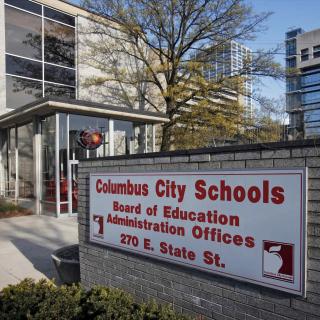Ten days after Governor James A. Rhodes assumed office on January 14, 1963, a Cincinnati FBI agent wrote Director J. Edgar Hoover a memo stating: "At this moment he [Rhodes] is busier than a one-armed paper hanger . . . . Consequently, I do not plan to establish contact with him for a few months. We will have no problem with him whatsoever. He is completely controlled by an SAC [Special Agent in Charge] contact, and we have full assurances that anything we need will be made available promptly. Our experience proves this assertion."
Why would the FBI assert that the newly-inaugurated governor of Ohio is "completely controlled"? Media sources like Life magazine noted the governor’s alleged ties to organized crime and the Mafia in specific. Gov. Rhodes’ FBI file, obtained through a Freedom of Information Act request, suggests that it may be because of the FBI’s extensive knowledge of Rhodes’ involvement in the numbers rackets in the late 1930’s that the Bureau could count on his cooperation.
FBI declassified material suggests that the Bureau’s extensive influence over Governor Rhodes, perhaps due to their knowledge of his ties to the numbers rackets, may have played a role in the Governor’s hard line law and order tactics that led to the deaths of four students at Kent State in 1970.
A November 19, 1963 FBI memo, again from a Cincinnati agent to Director Hoover, outlines specific allegations from a Bureau’s confidential informant about Rhodes’ involvement in the numbers racket between 1936-38. The informant, a bagman for local organized crime, gave detailed information about pick ups at a cigar store located between Buttles and Goodale Avenues reportedly owned by Rhodes’ sister. Rhodes purportedly was running the gambling operation. Years ago, a Dispatch reporter told the Free Press that the governor had run a gambling operation in the Short North, called Jimmy’s Place.
As Rhodes assumed public office, first as a Columbus School Board member, and later as the Mayor of the city, he began to make overtures to Director Hoover. In a February 1949 letter, Mayor Rhodes invited Hoover to sit on the advisory board of the All-American Newspaper Boys Sports Scholarships organization. Hoover declined. Rhodes thanked him and then invited him to address a banquet for the National Newspaper Boys Association in August of 1949. Hoover again declined.
Two years later, Rhodes was again attempting to contact Hoover. On July 27, 1951, Rhodes called the FBI director’s office and at first refused to speak to Hoover’s assistant L.B. Nichols. When told that the director was in "travel status," Rhodes explained the important nature of his call. He wanted "to invite the director to attend a celebrity golf tournament, . . . since its benefits were to go to youth organizations and he knew of the director’s interest in youth work." Nichols declined on behalf of Hoover.
Finally, Rhodes persistence paid off. Rhodes and his wife were given a special tour of the FBI building in Washington D.C. on January 19, 1953. "During the tour Mr. Rhodes stated he wanted to say with all possible sincerity that during all these years he has had continued and absolute faith in one government agency – the FBI," reads the 1963 memo.
The "completely controlled" memo showed great sympathy to Rhodes’ youthful gambling enterprise: "It is understandable that Rhodes has previously said that it was necessary during the Depression to do many things to keep body and soul together and to provide food for existence." Although the FBI fails to point out that Rhodes came from an affluent family who paid his way at Ohio State University during the Depression.
The memo goes on to describe Rhodes in the following manner: "He is a friend of law enforcement and believes in honest, hard-hitting law enforcement. He respects and admires FBI."
Moreover, the agency recommended taking "no further action" against Governor Rhodes and his alleged ties to the gambling racket since, "persons very close to him, such as SAC contact Robert H. Wolfe, Publisher, the Columbus Dispatch, speak very highly of Rhodes and his personal attributes. Wolfe knows Rhodes well and was an active financier of the campaign of Rhodes . . . ."
The SAC of the Cincinnati office took special interest in Rhodes’ first election as governor. Incumbent Governor Michael V. Disalle had hired a former FBI agent to investigate and dig up dirt on Rhodes: "We have arranged with friendly newspaper contacts to endeavor to avoid any headline or other prominent mention of the former FBI status of [deleted]."
Following Rhodes’ 1962 election, the FBI described the governor-elect in the following terms: "Rhodes is a Bureau friend of long standing. Our first contact of record was in November, 1943." The memo goes on to record that, "On June 18, 1945, the SAC of Cincinnati transmitted a news clipping from the ‘Columbus Dispatch’ of 6-7-45 indicating that Mayor Rhodes urged the establishment of a Bureau field office at Columbus." Rhodes is portrayed as very "active and very friendly toward the Bureau." Later FBI files would not include these early contacts between the FBI and Rhodes.
The Bureau does detail one obvious connection between Rhodes and organized crime in Columbus: "One informant stated that the gambling element in Columbus has made a great effort to influence Mayor Rhodes to permit open gambling in the city but without success. In 1949, however, it was noted that the informants alleged that Rhodes did not interfere with the ‘numbers racket’ as apparently he was still interested in the colored vote."
In July of 1963, a memo from the Cincinnati office on the subject of "Communist Speakers on College Campuses" noted that "Governor James A. Rhodes has signed into law legislation authorizing the trustees of any state-operated college or university to bar from using campus facility any person that they wish to bar."
The SAC in charge of the Cincinnati Bureau wrote Hoover on October 9, 1967 to relay a conversation he had with Rhodes three days earlier regarding the civil unrest and riots that had rocked the nation during the summer of 1967. "During the conference, we discussed matters of mutual interest, particularly civil disorders and the high crime rate. The Governor told me that he would extend his full facilities, and he is all for stopping racial discord the moment it starts. He revealed that his plan is to immediately deploy troops and/the state patrol as soon as trouble arises," the memo states.
The Cincinnati SAC concludes, "Our relationship with the Governor is of the highest order and he assured me that we can expect full cooperation from the State of Ohio on any matter of mutual concern."
By the mid-1960s, the CIA and the FBI were working together through the National Security Agency (NSA) to spy on radical groups and harass peace organizations. The FBI’s operation was known as COINTELPRO. The CIA’s was Operation CHAOS.
In 1967, declassified government documents reveal that CIA Director Richard Helms, Hoover and President Lyndon Johnson believed that the domestic protest movements against the Vietnam War were being orchestrated by the Communist governments in Moscow, Peking, Havana and Hanoi.
Governor Rhodes used former SAC Ed Mason as an intermediary in an attempt to meet with Hoover on March 25, 1968. The FBI memo on the matter reads, "He formerly served as mayor of Columbus, Ohio and is a good friend of [deleted] of the ‘Columbus Dispatch.’"
The FBI memo said, "SAC, Cincinnati advises that Rhodes has been extremely cooperative." Surprisingly, "there’s no indication that Governor Rhodes has ever met Mr. Hoover and he has not received an autographed photograph."
Less than year before the tragic shootings at Kent State, the SAC of the Cincinnati Bureau sent Hoover a memo detailing Rhodes’ attitude towards civil unrest: "He personally feels that the Director is the outstanding American and that he is the only person who has consistently opposed those persons who would subvert our government. He feels that the Director’s stated position of dealing firmly with these groups is the only sensible method."
"He [Rhodes] commented on the riots and unrest which have occurred repeatedly and said that some of this might well have been avoided if the Director’s warnings and advice had been followed. In Ohio, he has not hesitated to use the National Guard to deal with these situations and has instructed the Guard to act quickly and firmly. He feels that this is the only way to maintain law and order, and that the maintenance of law and order is the only way our government can survive," the memo records.
On May 4, 1970, Sandra Scheuer, Jeffrey Miller, Allison Krause and William Schroeder were shot dead by the Ohio National Guard at Kent State. Numerous investigative accounts have alleged that the FBI was involved in the burning of the campus ROTC building, which led to the deaths of the students.
The SAC in Cincinnati paid a "courtesy call" on Governor Rhodes 18 days after the shootings. Governor Rhodes informed the FBI agent that he intended to keep the Ohio State University campus open, despite what some historians regard as one of the largest student riots in U.S. history. ". . . He [Rhodes] intends to mobilize sufficient members of the Ohio National Guard (ONG) to accomplish this, ‘even if he has to put a guard in every classroom,’" the memo reads.
The Governor blamed the unrest on outside agitators and "commented that of the upwards of 100 persons arrested on May 21 and May 22, 1970, only a few were OSU students. . ." the memo notes. The FBI memo cites that of the 78 arrests, 35 were OSU students and two OSU employees, even though the majority of the arrests were made off-campus.
". . . the Governor also referred to the current investigation at Kent State University (KSU) and commented that he felt this would present an excellent opportunity for the Department of Justice, through some detailed statement to the news media after the investigation is completed, to get to the public the true story of campus agitation and to identify the organizers of the violence. The Governor appeared somewhat concerned at the possibility that members of the Ohio National Guard might finally end up being charged with an offense in connection to the shooting of the students at Kent," the memo stated, "He commented at one point that if the ONG members were indicted in regards to this matter that he felt a million dollars should be spent to defend them, if necessary."
The memo also records for history that, "The Governor commented several times on the close relationship he has enjoyed with the Bureau locally and as a whole."
Critics have long charged that the FBI deliberately covered up information about those responsible for ordering the Kent State shootings. A tape was recently released revealing what appears to be an order to shoot at Kent State. FBI declassified docouments strongly suggest that the FBI's extensive influence over Governor Rhodes, perhaps due to their knowledge of his ties to organized crime and the numbers rackets, may have played a key role in the Governor's violent and repressive tactics that led to death of four students at Kent State in 1970.
--
Bob Fitrakis is the Editor & Publisher of http://freepress.org. Revised May 3, 2007. Originally posted on April 21, 2003.




